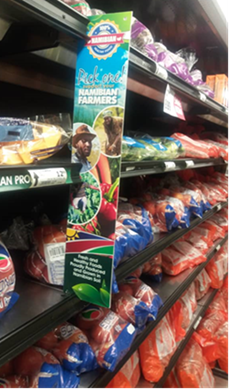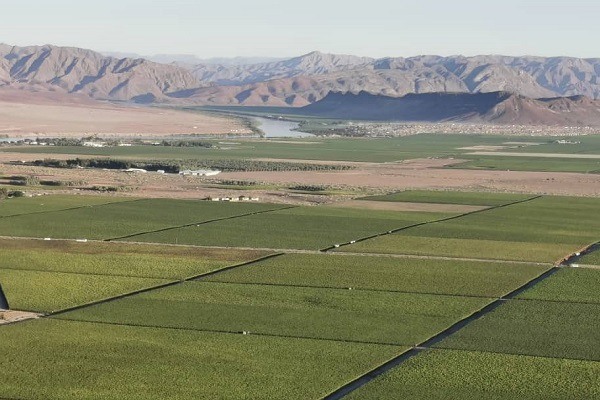
For the past nineteen years Namibia has been assessing availability of certain fruit and vegetables every month to determine whether the country has enough and whether imports are needed.
Right: Proudly Namibian fresh produce
In 2005, when the market share promotion scheme was introduced, Namibia was still importing 95% of its fruit and vegetables when really, such a small population – 2.6 million people – ought to be able to feed itself, remarks Gilbert Mulonda of the Namibian Agronomic Board.
So why did the realization that Namibia has been closing its borders for almost twenty years seem to only dawn this year, with media claiming this was "keeping South African farmers up at night"?
"We were also surprised by the attention," Mulonda says, "but I think what triggered it was the border closure of potatoes around July or August last year because we had quite a lot of local potatoes."
When trade is unimpeded, Namibia imports around 4,000 tonnes of South African potatoes every month, 70% to 80% of its potato needs, a situation which frustrates them, but Mulonda notes that the National Association of Horticultural Producers (NAHOP) is importing potato seeds for smallholder farmers from South Africa and France.
Dissimilar approaches to South African competition from Namibia and Botswana
South African media reports were confusing the transience of Namibia's bans with the permanence of Botswana's bans, to which Mulonda observes: "The moment you mix Namibia and Botswana it looks like Namibia also has permanent bans, but we only ban when we have sufficient production."
Mulonda and his colleagues remain convinced that their end justifies the means. The Namibian Agronomic Board identified twenty vegetables which, when in season, ought to receive preference over (mostly) South African produce. Buying produce from South Africa was cheaper and easier for traders, for sure, he acknowledges, and at the Cape Town fresh produce market a single visit could supply them with everything they need, then trucked to Namibia, a journey of two or three days.
How else to reduce the fierce competition from a superproducer like South Africa but by artificially protecting local production, they reasoned, and almost two decades on, Mulonda says the number of vegetable and fruit farmers has increased, even among former cattle farmers who'd been forced by drought to look for other pastures.
Namibia grows 56% of its veg since start of bans
Fortunately, 100% of Namibia's horticulture is irrigated from perennial rivers, aquifers, dams and boreholes and the large-scale adoption of horticulture takes the country in the right direction, he says, instead of the traditional cattle husbandry.
Today the country grows 29,468 tonnes of vegetables, supplying 56% of its needs from merely 5% in 2005, he says. The original aim of 60% self-sufficiency twenty years on has been held back by factors such as the availability of disease-free potato seed, high input costs and the absence of a legal framework to protect plant breeders. "For the top twenty vegetable lines that are restricted for importation during times of sufficient local production, local production marketed accounts for over 70% of the demand and only 30% is imports, except for potatoes and sweet potatoes that are still below 40% local production."
Namibian produce is on average 10% to 15% more expensive than South African produce, he says, but consumers will not necessarily notice the difference. "The pricing mechanism we use is not based on supply and demand, it's based on import parity," he explains. "When a Namibian trader would want to buy, say, tomatoes they'd first check how much it costs at the Cape Town market. That's how they determine the price."
Blueberries to expand by 50ha annually over coming decade
Namibia still imports 96% of the fruit it eats. Less than 1% of Namibian table grapes are eaten within the country and the fruit is considered a luxury, as it's too expensive for most.
The largest category of locally grown and eaten fruit is oranges, satisfying local orange demand by 15% only, and some small quantity of oranges exported to Angola and South Africa.
The approximately 100 hectares of blueberries are planned to expand by an annual 50ha over ten years. "All Namibian-grown blueberries are exported to the European Union and Asia. Namibia has the comparative advantage of being at least three to four weeks earlier than our competitors with both grapes and blueberries."
Bananas are grown non-commercially in communal northern areas of Namibia. The first of a series of trial blocks with two varieties has been established on 1ha in the Singalamwe area of Zambezi Region.
 Namibians eat less than 1% of the grapes grown in the country
Namibians eat less than 1% of the grapes grown in the country
"We believe trade within SACU must avoid exploitation"
Border closures have been a concern for South Africa for some time, raised with their Namibian counterparts and at the South African Customs Union (SACU), the regional trade bloc.
"Namibia is a member of SACU but we believe trade between member states must be balanced to avoid exploitation by a one-member state and potential trade wars," Mulonda maintains, noting that the biggest trade opportunities for SACU members lie not within the trade bloc, but outside. "Collectively SACU can become a big player in continental and global markets because we can't trade what we both have. It's not going to work."
He believes that the SACU agreement need to be reviewed. "The priorities of certain member states have changed since the SACU agreement was signed. We need to resolve the problem that leads to protectionism amongst members state with developing industries."
The selective import ban will not be in place forever, he adds. The not yet-released crop value chain development strategy for 2025 to 2030 will not contain a reference to the stimulus scheme, he says. "The aim is to move away from protection and border closures and position the industry to be competitive. The scheme was meant to trigger local production, which it has done. It will be a slow progress but we foresee that within the period of 2025 to 2030 some of these measures will be relaxed over time."
Namibia will have to assess the feasibility of relaxing the seasonal import bans, he states, based on the best interests of the industry.
Growth in Namibian vegetable exports
Namibia's vegetable production has responded to the stimulus programme to such a degree that today Namibian-grown vegetables are exported, tomatoes and bell peppers to South Africa, around 13,000 tonnes of onions to Angola and South Africa.
Sonop Farms, among the best-known of Namibia's vegetable growers
Although not the primary aim of the market share promotion scheme, exports are a natural progression to Namibian horticulture, which is 100% irrigated and therefore less vulnerable to the drought declared as a state of emergency when part of the Zambezi River nearly ran dry for the first time in living memory this year. It is the fourth state of emergence declared as a result of drought since 2010.
Mulonda says he understands why a South African tomato farmer might feel aggrieved at seeing Namibian tomatoes in South Africa while theirs may not cross the border.
"We understand those sentiments, but the whole idea, when we started this scheme, was to promote local products. We were very clear that the scheme was temporal to stimulate local production, and we've managed to do that. It was not easy."
He continues: "The advantage is that Namibia is a very small country. We're not under pressure as a result of a growing population yet in terms of food, the way that South Africa is. Our country needs very small production of staple crops in which the possibility of organic growing is possible, instead of producing staple grain crops that are genetically modified organisms (GMO)."
Growing vegetables when all inputs are imported – and in the case of seeds, fertilizers and chemicals, doubly imported via South Africa – drive up costs which they'd be keen to bring down. The feasibility of a fertilizer mixing facility near the port of Walvis Bay is one possibility to do that.

For more information:
Gilbert Mulonda
Namibian Agronomic Board
Tel: +264 61 379 500
Email: [email protected]
https://www.nab.com.na/










